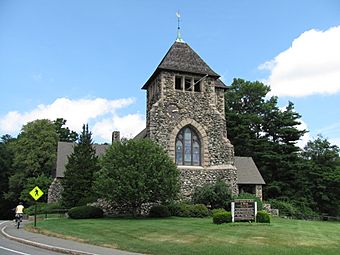Boston Post Road Historic District (Weston, Massachusetts) facts for kids
Quick facts for kids |
|
|
Boston Post Road Historic District
|
|

First Parish Church
|
|
| Location | US 20 and Boston Post Rd., Weston, Massachusetts |
|---|---|
| Area | 760 acres (310 ha) |
| Architect | Multiple |
| Architectural style | Georgian, Federal |
| NRHP reference No. | 83000783 |
| Added to NRHP | February 11, 1983 |
The Boston Post Road Historic District includes a part of the old Boston Post Road. This historic road once connected Boston, Massachusetts to Albany, New York. In Weston, Massachusetts, the district follows almost all of United States Route 20. It also includes a section that goes through the town's center.
This 3.5-mile (5.6 km) stretch of road still looks much like it did long ago. It keeps its old rural feel from the colonial period. The town center also has many historic buildings and features. This district was added to the National Register of Historic Places in 1983.
Contents
History of the Boston Post Road
The Boston Post Road was one of the first big roads built in colonial New England. This means it was built when America was still made up of colonies. The part of US 20 in Weston was first a path used by Native Americans. People started using it as a post road in 1673.
Weston was once the western part of Watertown. Its town center grew around its first meeting house, built in 1695. A meeting house was a building used for both church services and town meetings. In 1783, the road was improved so that stagecoaches could use it. Stagecoaches were like early buses that carried people and mail.
Old Buildings and Their Stories
Some of the oldest buildings along the road were taverns. Taverns were like inns or restaurants for travelers. The Golden Ball Tavern (built in 1763) and Josiah Smith's (built in 1757) are two examples. These places helped travelers who were passing through.
The road was very important during the American Revolutionary War. American fighters, called Patriots, used it to move soldiers and supplies. One important spot is Lamson Park. Here, Weston's local soldiers gathered before going to the Battles of Lexington and Concord in 1775. The Golden Ball Tavern was also important. Its owner was loyal to the British king, which led to protests there.
Changes Over Time
The Boston Post Road became less important in the 1800s. Newer, more direct roads, called turnpikes, took its place. Because of this, the road kept much of its rural look. It did not get too many new houses or big changes. The town center grew a little to fit more people, but it still feels historic.
What the Historic District Includes
The historic district covers the entire 3.5-mile (5.6 km) length of US 20 in Weston. It also includes an older part of the post road that goes through the town center. This section was bypassed, or routed around, in 1931.
The district is very large, covering over 750 acres (300 ha). In the eastern and western parts, properties are spread out. But around the village center, buildings are closer together. This central area includes the original town green, the two historic taverns, several churches, and town buildings.



